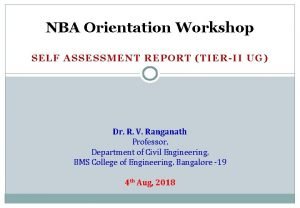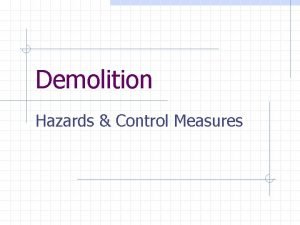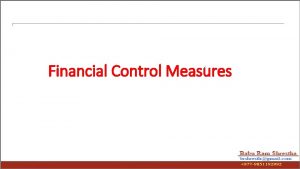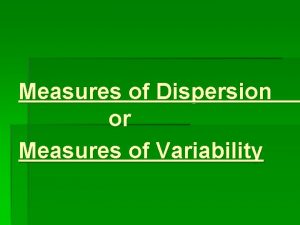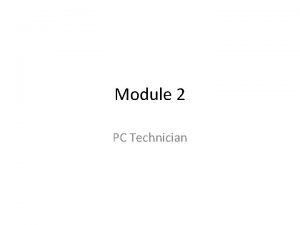Control Measures Control Measures n Focus on safety
















- Slides: 16

Control Measures

Control Measures n Focus on safety and quality n n n Food safety control measures -- prevent foodborne illness. Food quality control measures -- maximize shelf-life, slow spoilage, or produce a new product. Processors use a combination of controls n n One-control system can be harsh making food unacceptable to the consumer. Multiple controls is called the hurdle concept and is commonly used. C 5. 01 -- Control Measures

Hurdle Concept n n Food processors use a combination of control measures called hurdle concept. The three primary control measures are: 1. Controlling water activity and/or p. H values of the food. 2. Adding chemicals, such as additives or substances like salt, directly to the food. 3. Adjusting the atmosphere surrounding the food using special packaging methods. C 5. 01 -- Control Measures

1 a -- Controlling Water Activity n Water activity (Aw) n n n Minimum, optimum, and maximum values Yeasts and mold grow at a lower water activity than do bacteria. 0. 85 safe cutoff for pathogen growth n Based on minimum water activity needed for S. aureus toxin production. C 5. 01 -- Control Measures

Water activity and foods Above 0. 85 Moist foods Refrigeration or another barrier to control pathogen growth 0. 60 and 0. 85 Intermediate No refrigeration, short shelf-life moisture foods because spoilage by yeast and mold Below 0. 60 Low moisture foods Extended shelf-life without refrigeration C 5. 01 -- Control Measures

Controlling water activity Method Foods Hot air drying Solid foods like vegetables, fruit, and fish Spray drying Liquids and semi-liquids like milk Vacuum drying Liquids like juice Freeze drying Variety of foods Adding salt or sugar Soy sauce, jams, salted fish C 5. 01 -- Control Measures

1 b -- Controlling p. H n Minimum, optimum, and maximum p. H values for microbial growth n n Yeasts and mold grow at low p. H. Pathogenic bacteria do not grow at 4. 6 or below. n p. H controls growth and is not a method to kill pathogens. C 5. 01 -- Control Measures

Ways to Control p. H n Acidification n n direct addition of acid to a low-acid food Use organic acids, acetic, lactic, or citric or add high-acid food to mixture Direct – predetermined amounts of acids added to individual finished product Bath – acid and food combined in large batches and allowed to equilibrate. Fermentation n Lactic acid bacteria produces lactic acid. C 5. 01 -- Control Measures

Measuring p. H n p. H meter § Digital method but expensive § Easy, the MOST accurate, and sanitary n Indicator solutions § § n Organic dyes used with dropper Solution turns pink or red in acid; green or blue in base Neutral solution may turn lilac and might be difficult to read Not totally accurate Indicator paper § Used by dipping § Turns yellow to red in acids; turns green or blue in bases § Easy but not completely accurate n Titration n Add base with know ph to an acid Uses burette Difficult to calculate math so recommended for those with chemistry knowledge C 5. 01 -- Control Measures

2 -- Adding Chemicals n n Preservation method might not prevent growth of all microorganisms. Add chemical preservatives, such as: n n n sorbates benzoates sulfites nitrites antibiotics C 5. 01 -- Control Measures

How Chemicals Function? n n Denature proteins. Inhibit enzymes. Alter or destroy cell walls. Alter or destroy cell membranes. C 5. 01 -- Control Measures

Common Chemical Preservatives Preservative Mechanism Benzoates Inhibit yeast or mold Sorbates Inhibit mold Propionic acid Inhibit mold Sulfites Antioxidant and antimicrobial Nitrites Inhibit C. botulinum Salt Inhibit pathogens, especially C. botulinum Antibiotics -- nisin Antimicrobial in cheese C 5. 01 -- Control Measures

Regulating Preservatives n Chemical preservatives are food additives. n n Approved uses and use levels in FDA’s Food Additive Status List. Addressed through product formulation. n n Processor must carefully control the quantity of food additive for each batch. Processing conditions must be scientifically established and followed C 5. 01 -- Control Measures

3 -- Adjusting the Atmosphere n n Packaging does not control the growth of pathogens, it is limited to the control of spoilage microorganisms. Two functions: n n Prevents contamination of the food and/or Extends the effectiveness of food preservation methods. C 5. 01 -- Control Measures

Types of Packaging n Reduced Oxygen Packaging (ROP) – prevents growth of microorganisms to extend shelf-life n n n Vacuum Packaging – air mechanically removed from the package before sealing Modified Atmosphere Packaging – flush with nitrogen, carbon dioxide, and/or oxygen before sealing. Controlled Atmosphere Packaging – retain atmosphere throughout shelf-life using an oxygen scavenger in packaging. C 5. 01 -- Control Measures

Packaging – Key Concerns n n If ROP used, must have barrier to C. botulinum. Barriers include: n n n Water activity below 0. 93 with refrigeration p. H below 4. 6; salt above 10% High levels of competing microorganisms Thermal processing in final container Freezing with frozen storage and distribution C 5. 01 -- Control Measures
 For adult
For adult Porter's generic strategies
Porter's generic strategies Cost leadership and differentiation
Cost leadership and differentiation Actor focus vs object focus
Actor focus vs object focus Repeated measures design
Repeated measures design Nba sar tier ii
Nba sar tier ii Triangular base pin curls
Triangular base pin curls Interim life safety measures examples
Interim life safety measures examples Which display mode is allowed for proper navigation?
Which display mode is allowed for proper navigation? Qbs safety care
Qbs safety care Personal safety vs process safety
Personal safety vs process safety Safety assessment for ind safety reporting
Safety assessment for ind safety reporting 00101-15 basic safety
00101-15 basic safety Basic safety construction site safety orientation
Basic safety construction site safety orientation Ad as unemployment
Ad as unemployment Pinch point safety
Pinch point safety Cdm demolition
Cdm demolition





